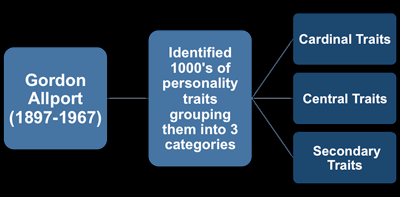Gordon Allport (1897–1967) was a respected and influential American academic working in the field of psychology. Allport, the son of a medical father and a teaching mother, was the youngest of four siblings, which gave rise to a keer interest in understanding humans motivation, impulses and personality, which led him to develop the theory of personality traits.
After graduating from Harvard University, Allport made a trip to Vienna, Austria, where he met Sigmund Freud, which would eventually influence his career and contributions to American psychology.
- After this experience.
- Allport returned to Harvard to earn his PhD in Psychology.
- During his career.
- Which developed in the first half of the twentieth century.
- He made important contributions to psychology.
- Among the most striking was the development of his ideas about personal traits.
- Which he called personal disposition.
According to Allport, these traits are influenced by our childhood experiences, our current environment, and the interaction between them. In Allport’s time, the idea was that personality traits could be made up of past and present forces. Allport believed the personality was made up of three types. of traits: cardinal, central and secondary.
Allport told the story of his visit to Freud in his autobiographical essay “Pattern and Personality Growth”. To break the ice when he met Freud, Allport said he had met a child on the train journey to Vienna. The boy did not want to sit next to a dirty passenger, despite his mother’s reassuring words. Allport suggested that the child may have had this phobia because of his mother, a very clean and seemingly quite dominant woman. After watching Allport for a few minutes, Did Freud ask you by any chance?”
Allport pointed out Freud’s intention to reduce this small part of the observed interaction to an unconscious episode from his own childhood, which reminded him that psychoanalysis tends to delve into both the past and the unconscious, going through this process in the supposedly most importantly, conscious. and immediate aspects of the experience.
While Allport has never denied that unconscious and historical variables can play an important role in motivating certain behaviors, his work will always focus on conscious motivations related to the current context.
In 1936, psychologist Gordon Allport discovered that a single English dictionary contained more than 4,000 words describing different personality traits. Allport’s personality trait theory classified them into three levels.
Among some historical figures who have shown a strong cardinal trait are Abraham Lincoln, for his honesty, the Marquis of Sade for Sadism and Joana D’Arc for his act of heroism. People with such personalities can become so known for these traits that their names are often associated with these qualities. Allport suggested that cardinal characteristics are rare and tend to develop over the years.
When present, cardinal traits shape the person, in the sense they have of themselves, their emotional composition, their attitudes, and their behavior; it is so clear that they can even be historically identified by them, as in the case of the Marquis of Sade. .
The central characteristics are the general characteristics that form the basic foundations of personality, these traits, although not as dominant as cardinal traits, would be the main characteristics that can be used to describe an individual. not absolutely dominant.
According to Allport’s personality trait theory, each person has between 5 and 10 central traits, which are present in varying degrees in each, include common traits, intelligence, shyness, honesty, and would be important determinants in most of our behaviors.
Secondary traits are traits that are sometimes related to attitudes or preferences, i. e. much less widespread and less relevant provisions, which often appear in certain specific situations or circumstances.
For example, an individual whose cardinal trait is self-affirmation may show signs of submission when police arrest him for speeding. This is just a situational trait that may or may not appear in other interpersonal encounters.
According to Allport, these secondary traits are quite difficult to detect because they are stimulated by a smaller scale of equivalent stimuli.
Allport’s personality trait theory is not directly based on experimental research, and is his largest Achilles heel. In fact, he has published little research to support his theory. However, in his first publication, with his brother, social psychologist Floyd Allport, he examined 55 male college students, depending on their core characteristics. After the survey, they concluded that traits were measurable in most students. The main objective of this research was to develop a scale as a means of “measuring” personality.
Gordon Allport’s curious initiative was to analyze a series of letters from a woman named Jenny Gove Masterson. Jenny’s 301 letters in the last eleven years of her life to a friendly couple were acquired by Allport and analyzed. Then, in an exercise, she asked 36 people to characterize Jenny based on traits they could identify in those letters.
For his study, Allport concluded that traits do not exist independently, and, at some point, behaviors that motivate two certain traits can conflict, so that, through hierarchy, one imposes himself on the other.
Although many theorists agree that people can be described by their personality traits, there is always a debate about the number of basic traits that make up the personality of the human being. For example, Raymond Cattell reduced the number of observable traits from 4000 to 171, then to 16, combining certain characteristics and eliminating the most unique or difficult-to-define traits. On the other hand, British psychologist Hans Eysenck has developed a personality model based on only three.
However, Allport’s research and personality trait theory are considered pioneering works in the field of personality, was based on statistical and objective data without personal experience, and also received some criticism, such as that it would not refer to the individual’s condition or condition. how you can behave temporarily.

